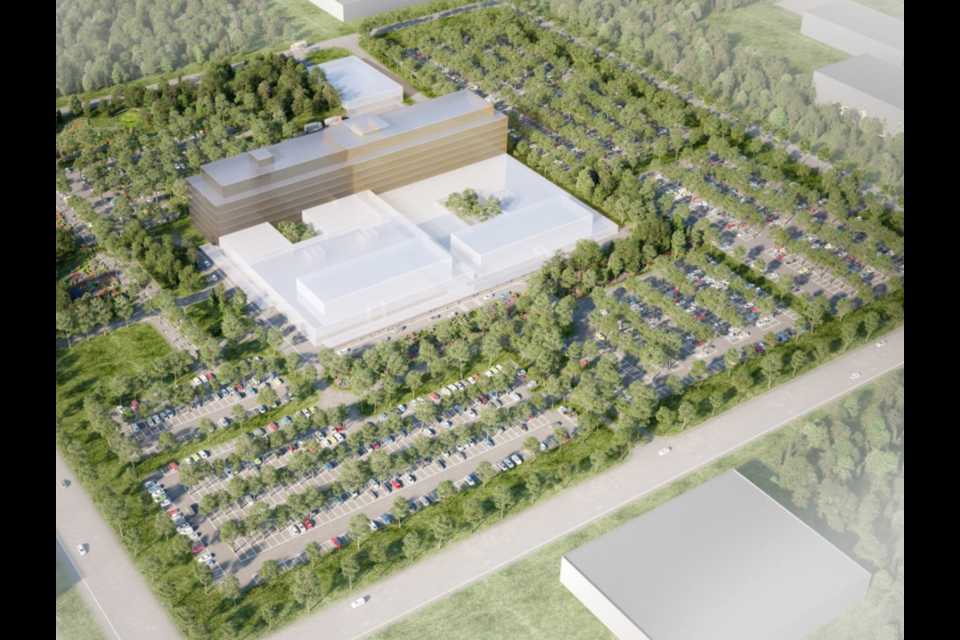Wednesday night was a historic one for Innisfil.
Those were the thoughts of Mayor Lynn Dollin, as town council voted to endorse a minister’s zoning order (MZO) requested by Royal Victoria Regional Health Centre (RVH) to permit a major hospital and community health hub on the southwest corner of Innisfil Beach Road and Yonge Street.
Earlier in October, RVH announced its intention to build its south campus at 7324 Yonge St. and 7250 Yonge St., across the road from the town’s civic campus and Rizzardo Health and Wellness Centre.
The MZO, if approved by the Ministry of Municipal Affairs and Housing, would propel the project forward.
“There is urgency to move forward with this project as soon as possible, so the opportunity is not lost,” RVH president and CEP Janice Skot told councillors Wednesday night. “(An MZO would) provide greater certainty that the south campus can be developed at this location.”
The MZO could see government approval be received for the site sooner rather than going through the traditional planning channels. This could mean shovels in the ground faster and, as Dollin was quick to point out, fundraising for the local project can begin sooner, as well.
None of this would be at the expense of community involvement or proper planning, Skot stressed. The resolution, as proposed, included provisions for the town to have a say in any revisions to the proposed MZO and that it would be deemed a bylaw passed by the town.
The properties in question are currently designated as agricultural. The MZO would establish a new community health hub zone, including an environmental protection zone, on the parcels of land.
“Of course, an MZO does not change the requirements for good planning and broad consultation,” Skot said. “Far from it. The site plan is still subject to all strict planning policies, including environmental protocols.”
In her presentation to council, Skot highlighted the immense community involvement which has already taken place. She touted more than 57,000 consultation interactions surrounding the south campus, with a wide variety of stakeholders, including Indigenous and francophone communities, diverse and vulnerable populations, LGBTQ+, youth, homeless, new immigrants, patients and families, staff, volunteers, and other partners.
RVH’s south campus is slated to be developed over a 20-year timeframe, with Phase 1, featuring an outpatient health hub (including an urgent-care facility) ready to be opened by 2027-28. Phase 2, which would consist of a non-critical care inpatient facility, would open by 2032-33, with the final phase, a complete acute-care hospital, opened by 2037-38.
That final phase would see up to 300 inpatient beds and a fully functioning emergency room. The hospital would serve as many as 350,000 patients each year, in a campus similarly sized to RVH’s current footprint on Georgian Drive in north-end Barrie.
Skot highlighted the project as a way to boost recovery as the province exits the COVID-19 pandemic, with RVH planning to add 3,000 more full-time staff between its north and south campuses by the end of the third phase. With most of those workers also living in Simcoe County, RVH’s economic spin-off could blossom to an estimated $870 million in 2038 from $256 million today, thanks to the expansion.
But to fully reap those benefits in the timeliest manner, an MZO is the best option at RVH’s – and town council’s – disposal, Skot argued.
“We know Innisfil residents want a hospital built in their community yesterday. Well, so does RVH,” she said. “It’s important to understand that the timeline to build a hospital is long and it’s complicated. We can’t risk delaying a south campus.”
The population of southern Simcoe County is going to double over the next 20 years, Skot said, increasing the area’s health-care needs significantly. Meanwhile, the Barrie hospital has been operating at more than 100 per cent capacity, further heightening the need for the new facility in Innisfil.
Council passed the resolution unanimously in a record vote.



